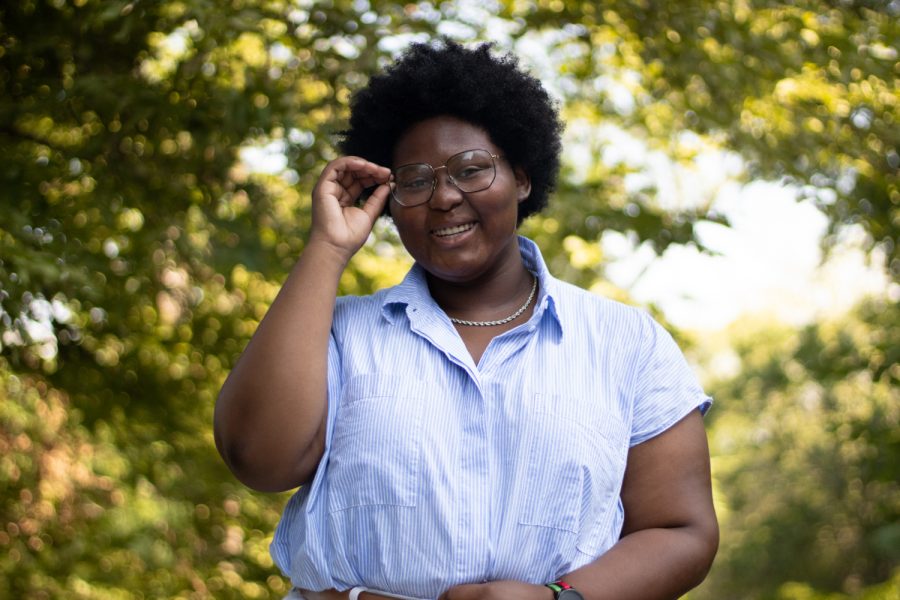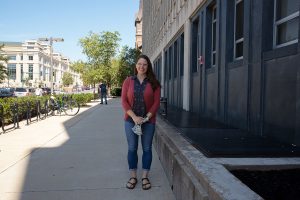Dasia Taylor plans next steps at the UI after creating innovative sutures
The Iowa freshman’s invention of color-changing surgical sutures changed the course of her high school career. She’s continuing her research and earning a political science degree at the UI.
University of Iowa freshman Dasia Taylor adjusts her glasses at the University of Iowa campus on Friday, Aug. 27, 2021.
August 29, 2021
To the world, Dasia Taylor is known for her groundbreaking invention of color-changing sutures, created when she was just in high school. Now, the Iowa City community also knows Taylor as a promising University of Iowa first-year studying political science.
“I count Iowa City as my hometown, I’ve lived here for six years,” Taylor said. “I have had a lot of opportunities here, but more importantly, I have had a lot of growth.”
While Taylor’s research is important to her, she said her involvement in diversity, equity, and inclusion work spearheaded her decision to major in political science.
Taylor said she also plans to go to law school after she finishes her undergraduate degree.
“I know that the DEI work I have started in this community, I want to do on a greater scale,” she said. “…I plan on going to law school, and I am not completely sure what type of law I want to practice.”
Iowa City West High School honors chemistry teacher Carolyn Walling, Taylor’s mentor, said she’s helped Taylor with her research since Taylor was 16. Walling said she has one slight issue with how Taylor views herself.
“One of my pet peeves with her is that she keeps saying she is ‘not a science person’,” Walling said.
In high school, Taylor researched and created surgical sutures that, when introduced to infected skin, will change color due to the pH level of the affected area.
Skin is naturally acidic with a pH of around five. But when an area becomes infected, Taylor said, the pH typically raises to around eight or nine, allowing for the color change.
“I don’t plan on stopping my research anytime soon, unless I get to a point where I am like this is solid, it’s commercially viable, let’s do it,” Taylor said.
Taylor said the diversity and equity work that she started – and the research she is still doing – was a major deciding factor when she chose to attend the UI.
RELATED: West High senior Dasia Taylor recognized as Regeneron Science Talent Search Finalist
“There is so much work that I had already started that I didn’t want to leave it in someone else’s lap,” she said.
Taylor said she has begun seeking a utility patent for her creation — a patent that covers the creation of a new or improved, and useful, product.
However, seeking a patent has been somewhat of a challenge for Taylor. She said she’s spent the better part of the last 18 months becoming well-versed in the process that could take up to two years to be approved.
Walling said she believes Taylor will continue to succeed in her endeavors, regardless of what they are, because she’s very motivated and a hard worker.
Walling said she attributes Taylor’s success to the unique project idea and the communication skills that she uses.
“She was able to explain it to anyone,” Walling said. “She could explain it to a five-year-old and to a Ph.D. scientist. She is just so gifted in that way.”
Award season and media attention
Since her project debuted for the first time, Taylor was a guest on The Ellen DeGeneres Show where she received a trophy from DeGeneres to acknowledge the “world-changing” work she’s accomplished in May.
Taylor, however, said those who have helped her since the beginning are part of her success.
“My mom and my grandparents have for sure been holding me down during this process,” she said. “When Ellen contacted me, or her team rather, I specifically requested that they fly out my mom and my grandparents.”
Despite the media attention Taylor has received, she said it has not changed her goal.
“I don’t think the media has changed me in any way,” she said. “It just enhances the knowledge that I exist and my research exists, and it gives people hope.”
Walling said Taylor has inspired many with the attention that the sutures have received.
“For her, it’s been a cool thing, because she has met so many interesting people and she has also inspired so many people,” Walling said.
Taylor said her story has been shared internationally and has reached thousands of people, some of which have expressed to her their thoughts and feelings.
“I still get fan mail to this day. People send me things from all over the world,” she said. “…I remember a particular day that an international school in Luxembourg, Germany, sent me fourth and fifth grade class letters that are actually at home safe.”
In February, Taylor said she got an Instagram notification that someone had tagged her in a post.
“It was an artist that is based in New York City,” she said. “They drew me as a part of their Black History Month spread.”
The artist, Jerlyn O’Donnell, @commuteartist on Instagram, drew Taylor to spread the word about her and other people of color.
“When I saw Dasia … I was like, ‘more people need to know her,’” O’Donnell said.
Since posting about Taylor, O’Donnell has self-published multiple books, one of which includes more art of Taylor in order to make O’Donnell’s personal goal more attainable.
“I eventually want to make a world where people don’t have to look for people that look like them,” O’Donnell said.
Taylor said the main benefit coming from the media attention and fan mail is the ability to see how she is positively affecting the world.
“Actually, having that experience of like, ‘Hey, I’m actually making a difference in the world’ has been even greater, and that has been reflected in some of the things people have sent me,” Taylor said.






